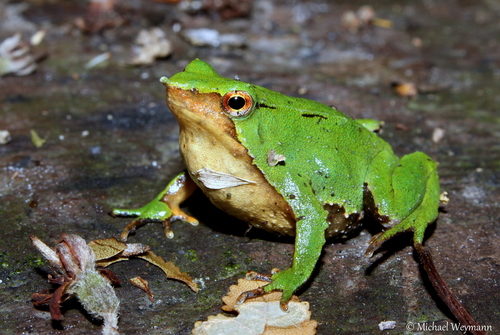
Darwin's Frog
Darwin's frog, with its unique leaf-like body, thrives in Chile's lush forests. Distinguished by the male's brood pouch, it nurtures young in its vocal sac. A crucial insect predator, this tiny amphibian exemplifies nature's ingenuity, blending seamlessly into its environment while playing a pivotal ecological role.
10-15 years
Lifespan
2.0 - 5.0 g
Weight
Length: 3 - 4 cm
Size
Brown, Grey, Black, Tan, Green
Color
5 mph
Top Speed
Endangered
Conservation Status
Decreasing
Population Trend
Characteristics
Rhinoderma darwinii, commonly known as Darwin's frog, is a small amphibian native to the temperate forests of Chile and Argentina. Notable for its leaf-like appearance, this frog exhibits remarkable parental care, with males carrying tadpoles in their vocal sacs until they metamorphose. It plays a vital role in controlling insect populations.
Distribution Range of the Darwin's Frog
Rhinoderma darwinii, commonly known as Darwin's Frog, is native to the temperate forests of southern Chile and Argentina. It is primarily found in the Andes mountain range, with its distribution extending from the Maule Region in central Chile to the Los Lagos Region in southern Chile, and marginally into adjacent areas of Argentina.
Darwin's Frog's Habitat
Environmental Conditions
Darwin's Frog inhabits temperate, moist forests with a preference for dense, humid environments. These forests are characterized by a cool, wet climate with significant rainfall distributed throughout the year. The species is often found in areas with abundant leaf litter and close to freshwater sources such as streams and small rivers, which provide necessary moisture and habitat conditions.
Ecological Niche
The ecological niche of Rhinoderma darwinii involves its unique reproductive behavior, where the male carries the eggs in his vocal sac until they develop into fully formed froglets. This adaptation allows the species to thrive in its moist, forested environment by minimizing the risk of egg predation and desiccation. The species is primarily insectivorous, feeding on small invertebrates found within its forest habitat. Its reliance on pristine forest environments makes it particularly vulnerable to habitat destruction and environmental changes.
Copyright @ Nature Style Limited. All Rights Reserved.
 English
English